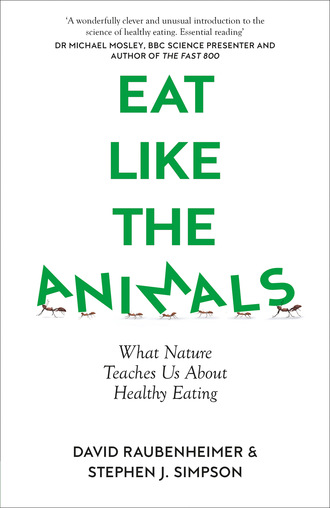
Полная версия
Eat Like the Animals
But what exactly is a Calorie?
It’s simply a unit of energy—a single Calorie is the amount of energy needed to raise the temperature of 1 kilogram (2.2 pounds) of water (which is the same as a liter) by 1 degree Celsius, from 14.5 to 15.5 C. Yes, this is a bizarre currency indeed, except, perhaps, if you have ever wondered how much food it takes to heat a bathtub. But it is rigorously exact, which we scientists tend to like. And so, everyone is stuck thinking in calories, even though they are hard to picture.
To confuse things further, you may also see calories written as kilocalories (kcal). This is because 1 Calorie (with a big “C”) equals 1,000 calories (with a small “c”). You may also have seen the energy content of a food presented as kJ—kilojoules, which is what we scientists mainly use, along with kcal. These units have an even more unlikely-sounding definition: 1 kJ is the energy needed to move a 1-kilogram (2.2-pound) weight by a force of 1 Newton (which is itself a measure of gravitational pull), over a distance of 1 meter. One kilojoule equals 0.239006 Calorie (to be exact!).
In this book we will mainly use “kcal” when presenting units of energy, but on occasions when presenting scientific results, we will use “kJ.” Throughout, we will use “calories” with a small “c” as a generic term for “energy.”
This means we determine the energy contained in food based on its theoretical power to fuel action—to heat water or move weights.
All food contains calories, with the exception of water, which is just as well, because without energy, our bodies wouldn’t be able to do anything, including make use of the other important thing we take from food: nutrients. Energy comes from the main nutrients in our diet—the macronutrients, as they are known—each of which is chemically different. Once we consume these nutritional fuels—proteins, carbohydrates, and fats—they are broken down into smaller molecules that are burned within our cells.
Macronutrients deliver more than just energy, however. Proteins and their building blocks, the amino acids, also supply nitrogen, with which we make all sorts of other important things, including hormones, enzymes, and the information-storing molecules DNA and RNA. If we don’t ingest protein, we don’t live.
In the popular mind (and in many diet books), fats and carbohydrates (carbs) have almost become just another way of saying “Calories,” but there is a lot more to them than that. Fats insulate us from the cold, store vitamins, lubricate the skin, and cushion our eyeballs and joints. Their fatty acid building blocks make up the membrane that surrounds every cell in our bodies, and special fats called sterols serve as messengers that help coordinate the complex chemistry that keeps us alive.
We can’t do without fats.
Carbohydrates include sugars, starches, and fibers. Like proteins and fats, most carbs are built of smaller units, in this case, simple sugars such as glucose and fructose. The nutritional properties of different carbs depend on which simple sugars they consist of and how they are strung together. The most abundant carbohydrate on our planet—the plant fiber cellulose—has its glucose units strung together so tightly that we can’t digest it.
Glucose is particularly important because it’s the main carbohydrate on which our bodies depend. In addition to providing energy, glucose partners with the nitrogen from protein to build DNA and RNA.
Our bodies can create glucose by breaking down proteins and fats, so, strictly speaking, we don’t have to eat any carbs to get glucose. But that is not the same thing as saying we don’t need to eat carbs at all—as we will show later.
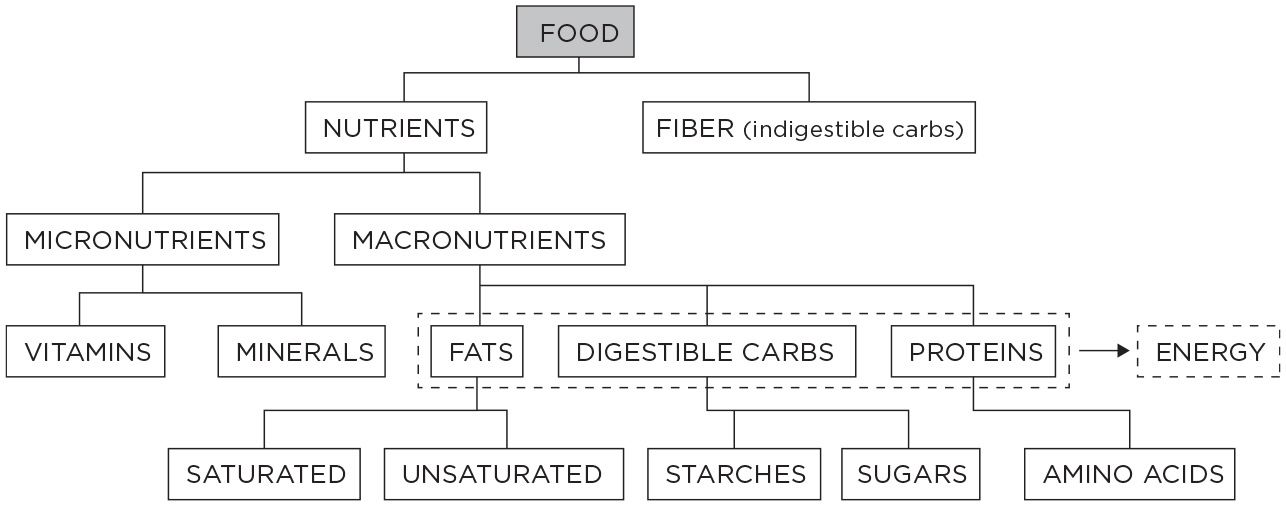
A schematic showing the relationship between foods, nutrients, and energy.
And those are just the macronutrients. Vitamins and minerals are needed, too, though in tiny amounts compared with the big three, which is why they are called micronutrients. These are used by the body for too many purposes to mention here. But keep in mind that sodium, calcium, magnesium, chloride, and potassium all generate electrical currents that quite literally make us tick—our hearts beat and our nerve cells crackle with electrical impulses.
The diagram above provides a summary of what’s in food. Should you want to know more about the different boxes in the diagram, check out More on Nutrients, which may also be of use at specific points when reading the rest of the book.
As we can see from the diagram, foods are complex mixtures of many nutrients; not to mention diets, which are themselves complex mixtures of foods. To understand nutrition, we need to think not in terms of single nutrients but rather the balance of nutrients in these mixtures.
If an animal is to thrive, it needs to eat macro- and micronutrients in the right amounts—like Goldilocks, not too little, not too much. Some animals, such as parasites living within the body of their host, get all the nutrients they need, and in the right balance, from a single food source. For them, choosing the proper diet is easy. All mammals, including ourselves, are lucky to start life in such ideal circumstances—because mother’s milk is as close as we’ll ever come to a perfectly balanced diet. It contains, in proper proportions, everything a newborn needs to grow. But after a mammal is weaned, nutrition becomes a much trickier undertaking.
It’s easy to see why. The things we eat are made up of nutrients in almost endless combinations. Some foods are richer in protein, others in fats or carbs—but all are mixtures. There are no single-nutrient foods. Pasta and bread certainly live up to their carb-rich reputations, but about 10 percent of the energy they contain comes from protein. A steak is a protein powerhouse but more than half of it is water, along with lots of fat and minerals, too.
We humans complicate matters even further because, unlike other animals, we tend not to eat single foods; rather, we assemble them into recipes and meals. Then we combine meals into varied diets and dietary patterns, sending complex mixtures of nutrients and other substances into our bodies, where they interact with our physiology.
Now, imagine having to consciously navigate and balance the proper mixture of all that on a thrice-daily basis. We would all need PhDs in mathematics and computing, and even then the calculations wouldn’t leave us time to do much else.
Thankfully, as Stella the baboon and the slimy blob showed us, nature is capable of handling complex challenges like this one without mathematics and computers. The solution is simple and elegant—and exists inside every living thing, as we shall see before long. But first, back to Oxford.
CHAPTER 2 AT A GLANCE
1 The key players in nutrition are calories, macronutrients (protein, carbs, and fat), micronutrients, and fiber.
2 You can check out More on Nutrients for extra detail.
3 Nutrition is about more than single things (fat, sugar, protein, or whatever)—it’s about mixtures of dietary nutrients and about their balance.
4 Mixing a nutritionally balanced diet seems daunting, but animals in the wild do it instinctively. How do they do it—and why is it so hard for us?
3
Picturing Nutrition
WITH CALORIES AND NUTRIENTS IN MIND, LET’S return to Oxford, where we left off in Chapter 1 sitting side by side at Steve’s computer to view the results of our big locust experiment. As was (and still is) usual for us, the first step was to make a simple visual representation of the data—a graph.
The graph itself looked like a large letter L. The vertical line, or axis, is where the computer would mark how much carbohydrate an insect ate in milligrams (mg). The horizontal axis would show how many milligrams of protein that locust consumed. Before we show the actual results, to help explain how to read the graph, here’s the hypothetical example of a locust that ate 300 mg of carbs and 200 mg of protein:
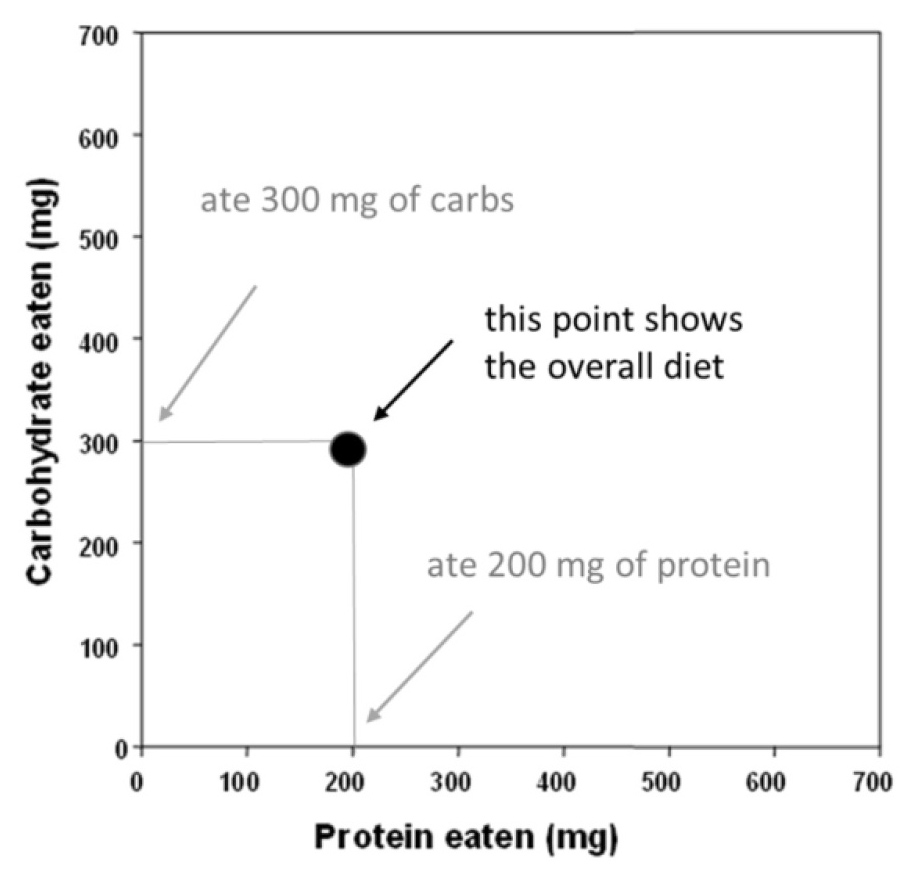
A graph showing how the intake of a locust eating 300 mg carbs and 200 mg protein would be plotted.
When we plotted the actual results for all the locusts across all the diets, we saw something fascinating. The intake points fell neatly along a line, rising like a drifting plume from the horizontal axis. So astoundingly simple was the pattern, that at first we suspected there was a problem with our arithmetic. We checked it and double-checked it. All was right.
Then we realized what we were seeing was real and important—although at the time, we didn’t know just how important. We were seeing, for the first time, how appetites for different nutrients interact to deal with nutritional imbalance. And, we already knew, dealing with nutritional imbalance is a big deal, a very big deal, in the natural lives of animals—it is essential for success. More than that, we had invented a new approach, which can be applied to any species, for unravelling the mysteries of eating. We called this Nutritional Geometry.
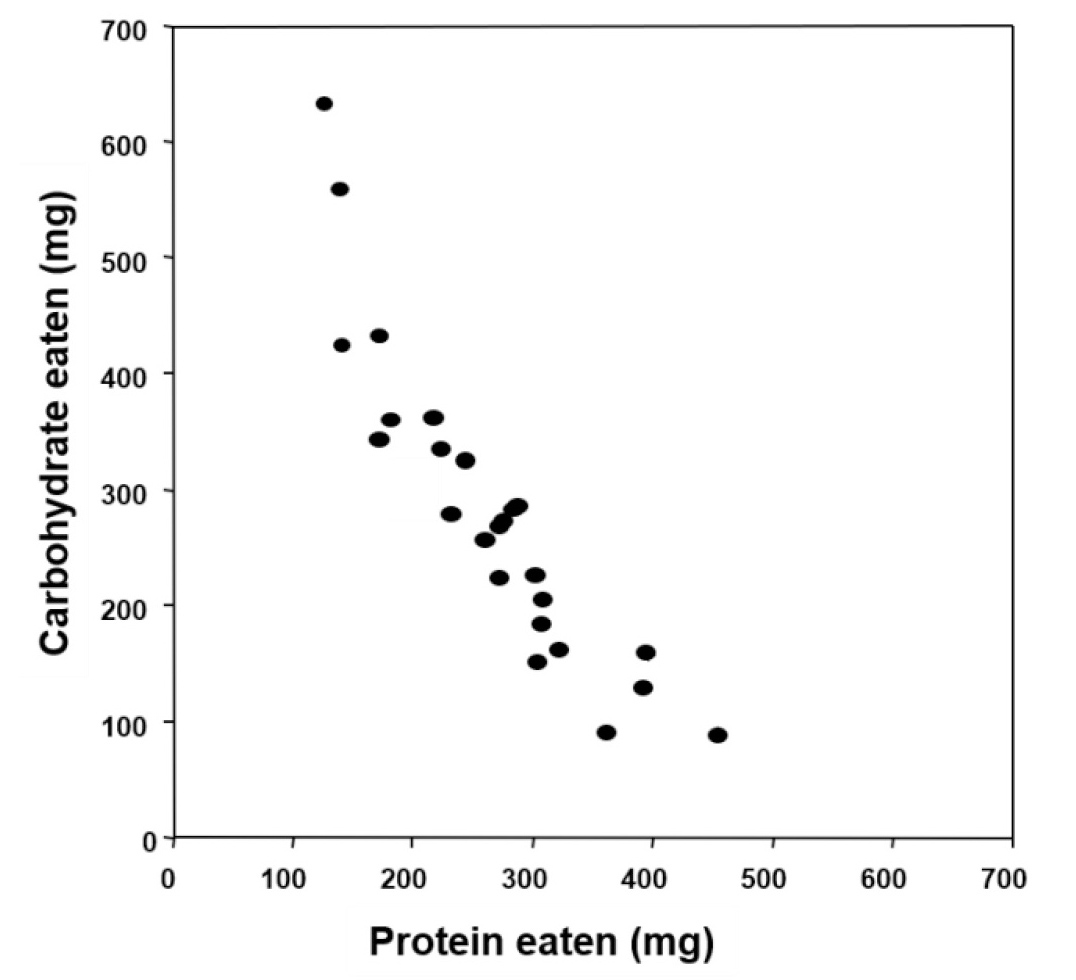
The plot of results from the locust experiment. Each point shows the protein and carbohydrate intakes (as illustrated in the previous plot) of locusts fed one particular diet. Note how the points rise upward in a plume. Each point shows the average intake of one group of locusts.
Having graphed the results, the next step was to work out which of the diets was closest to being nutritionally balanced for a locust. For that, we identified the mixture of protein and carbs that allowed locusts to grow and survive best—essentially, the healthiest nutrient balance possible. We called this the target diet and have marked it on the next graph with a bull’s-eye.
As you might imagine, the target is rather important not just for the locusts but for the concept of Nutritional Geometry itself. It allows us to see, at a glance, which diets are best balanced (the black points near the bull’s-eye) and which are imbalanced—all the rest. The further from the target, the more imbalanced. We can also see how exactly a diet is imbalanced. Those points above the target show locusts that ate too much carbs; those below ate too little. Only those on the target ate exactly the right amount!
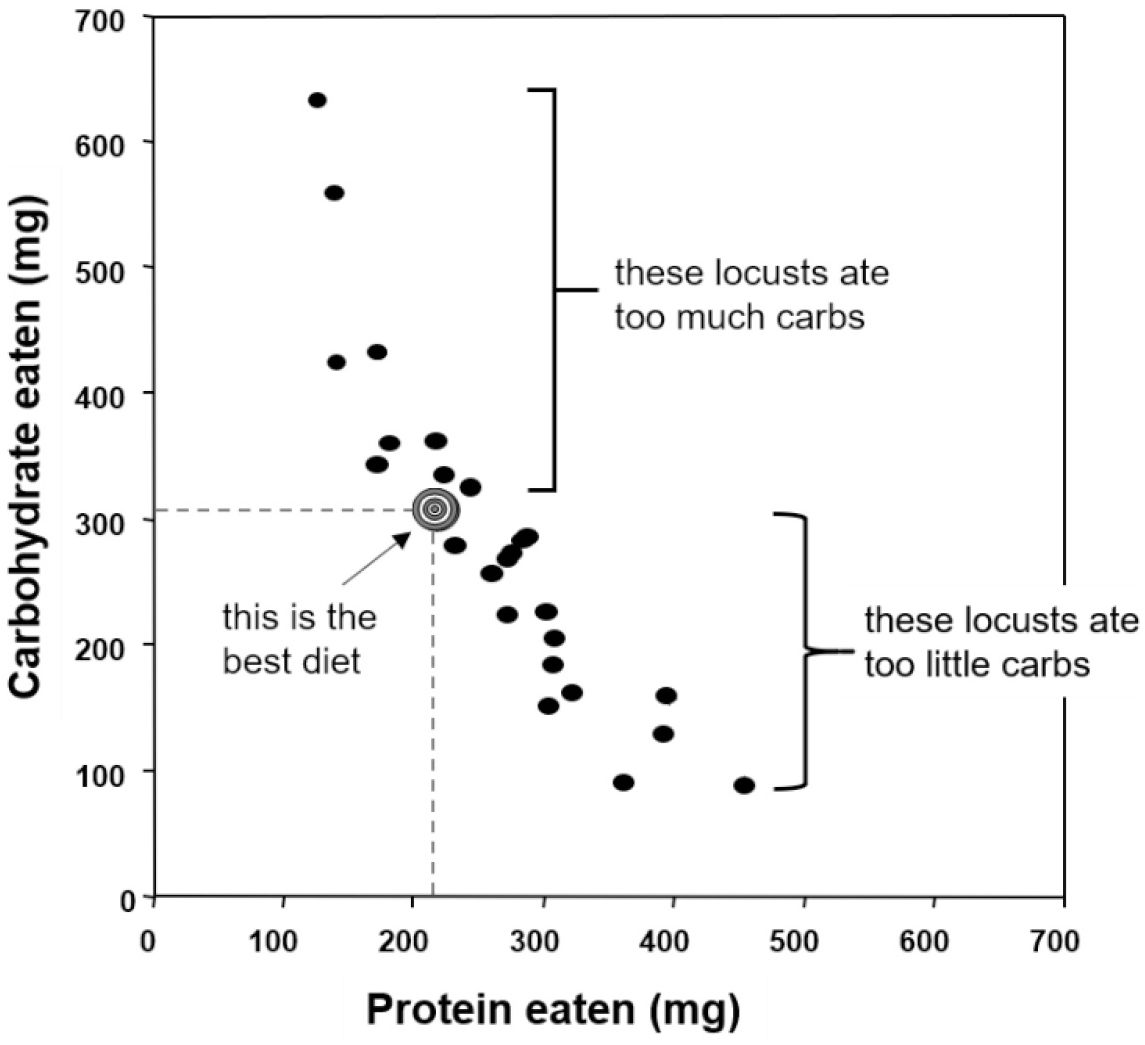
The bull’s-eye shows the diet that supported best survival and growth. Other points can then be interpreted relative to this target diet.
With those simple concepts in place, you can see something else that is important in our results. The locusts that ate too much carbs all line up vertically close to in line with the protein target, getting a similar amount of protein (about 150 mg, which is approaching the target of 210 mg). But to do so, they have had to overeat carbs—by a lot. And eating those extra carbs came at a cost—well, two costs. First, it took time. It meant that locusts on the low-protein, high-carb diets had to extend the period until they molted to become winged adults. The longer a locust delays getting to adulthood, the more likely it is to be eaten by a bird, lizard, spider—or another locust—before getting a chance to reproduce. The second price they paid is something you wouldn’t readily associate with an insect: locusts on the high-carb diets became obese. Granted, it’s hard to tell that a locust is fat, because its skeleton is on the outside. But it’s chubby on the inside, like an overweight knight wedged into a suit of armor a few sizes too small.
Locusts overate on high-carb diets to reach the protein intake target. But what about low-carb diets? Here we need to focus on the locusts below the bull’s-eye in the graph. You can see that the pattern of dots bulges out a bit to the right, meaning that the locusts’ protein intake was a bit higher than their target but way down on carbs. As a result, they were too lean and less likely to survive to adulthood compared with locusts on the target diet. Their body fat stores were so low that they would have been unable to fly far or live for long in the wild.
Once again: on high-carb feed, the insects had to keep eating (in order to get all the protein their bodies demanded), and they ended up consuming more carbohydrate than needed, becoming fat, and having to delay development. On low-carb food, they took in less carbohydrate (because they got their fill of protein sooner) but paid the price of being short of energy.
Our locust experiment had documented for the first time in any animal the battle between two nutrients—protein and carbs—as they competed for control of food intake on imbalanced diets. Protein won in the end. In fact, what we were seeing was not so much a competition between two nutrients but between two appetites—one for protein, the other for carbs. We next wondered whether the two appetites could work together to help the animal achieve its nutrition goal—a balanced diet.
CHAPTER 3 AT A GLANCE
1 The Oxford locust experiment provided a new way to define balanced and imbalanced diets.
2 Locusts had a target mix of protein and carbs for best growth and survival.
3 When their diet didn’t allow them to reach the target, protein was prioritized over carbs but at a cost to growth and survival.
4 We had documented for the first time the battle between two appetites—for protein and carbs. Can these two appetites work together to help the animal achieve its nutrition goal—a balanced diet?
4
Dance of the Appetites
IN THE EXPERIMENT, OUR LOCUSTS WERE EACH given a single food to eat. They could eat as much of it as they wanted, but they couldn’t change the balance of protein and carbs—that was determined by us. We had done this to set up a competition between the two appetites for protein and carbs to see which was more powerful; and as we just saw, protein won.
But what would have happened had the locusts been free to choose from a variety of foods? Would their appetites have worked together to help the insects navigate the proper balance of protein and carbs?
We asked a PhD student in our lab at Oxford, Paul Chambers, to create a nutritional challenge for locusts to solve. He offered the insects choices of two foods differing in their protein and carb content.
In every case, the insects did the exact same thing: they ate an identical balance of protein and carbs, regardless of which foods they were offered. To do so, they had to choose very different amounts of the two foods, depending on which pair was offered. It’s as if, regardless of whether we were offered meat and pasta, or egg and bread, or beans and rice, or fish and potatoes, we always consumed the exact same balance of protein and carbs. For us humans, this might seem a nearly impossible challenge. Somehow, the locusts solved the puzzle with ease.
Even more impressive, the combination of protein and carbs they chose exactly matched the bull’s-eye in our graph from the big locust experiment. They had chosen the healthiest combination of protein and carbs, the one that best supported survival and growth.
Our experiments even showed how the insects could tell if a food contained the nutrient they lacked. Locusts, like other insects, have taste hairs all over their mouthparts as well as on their feet and elsewhere. When these hairs touch something edible, the locust analyzes its chemical content before deciding whether to eat. If, say, the insect has recently taken in enough protein, these sensors will ignore that nutrient. It won’t even recognize that the nutrient is there. If, on the other hand, the locust is protein-deficient, the sensors, upon encountering protein, will send electrical messages to the brain saying, “Eat this”—and that is exactly what ours did, ignoring carbs.
We went one step further and showed that locusts could even learn to associate colors and scents with the protein and carb content of foods. We could train them to go to places where they had come to learn they would find what they craved. That’s a pretty smart thing to do for an animal with a brain the size of a pin head.
This proved that when locusts have a good choice of available foods, their appetite systems collaborate, and the insects combine the foods in exactly the right proportions to consume an optimally balanced diet. But when they are restricted to imbalanced foods, as in our big locust experiment, the appetites for protein and carbohydrate compete. And for locusts, in the end, protein always won.
All this detail about locust feeding was fascinating in itself—for us, at least. But it also raised a much bigger issue relevant to everybody: the possibility that what we had seen in locusts might apply to appetites across the entire animal kingdom, including humans. It is therefore worth looking at exactly what appetites are and how they work their magic (and sometimes, their mischief). This line of inquiry will also help answer a question that we are often asked: How do living things know, innately, what they ought to eat?
The first thing to bear in mind when trying to understand appetite is that nature has provided everything we eat with highly individual tastes—flavors. To us, a hunk of charred flesh tastes different from a handful of berries, which is different again from a bunch of juicy, dark green leaves. All this variety is no accident, nor is it simply to keep us from being bored at mealtime (but it does that, too). The flavor profile of a food indicates its chemical contents—its nutrients.
Given that proteins, fats, and carbs each have their own special roles and significance, both to provide energy and to perform other important functions, it comes as no surprise that nature has equipped us with the ability to tell the difference and thereby detect their presence in food.
We take this talent for granted, but without it, none of us would exist. It helps us to know what nutrients are contained in which foods and what we should eat and avoid. This need to find the proper foods is why we experience sugar as tasting pleasingly sweet, and why high-protein foods have that lip-smacking savory taste that the Japanese call umami, and fats have that rich, buttery mouth feel and flavor. Otherwise, how would we tell the nutrients apart?
We are not alone among the animal kingdom in being able to taste macronutrients, although some other animals possess their taste organs in unlikely places. A female blowfly, like a locust, tastes sugar and amino acids with her feet and with the tip of her abdomen to guide laying eggs on something suitably disgusting (to us at least) for growing her baby maggots. If that sounds gross, consider that we have taste receptors inside our intestines as well as in our mouths to help keep track of nutrients as they are broken down during digestion. After all, our gut is open at both ends—just as we taste food at the front end, we keep track of it all the way through. We even continue to detect nutrients after they leave the gut and enter the bloodstream, using receptors located in various organs—including the liver and the brain. The brain is where the appetite control centers reside. These are the neural circuits that collect together signals from the bloodstream, liver, and gut, generating feelings of hunger and fullness.
As is true for macronutrients, we have taste organs that can detect some of the micronutrients, including mineral salts, both on our tongues and scattered through our bodies.
Specific tastes and flavors provide information about which foods are which and how much of particular nutrients each contains. They are the external side of the feeding equation. This helps an animal decide what to eat, and there’s no need for us to tell you the importance of that. But tastes and flavors are not much good at telling the animal something equally important: how much of each nutrient it needs at a given time. That, the internal half of the equation, is taken care of by appetite systems.
It is a mistake, and one that is much more common than it ought to be, to think of appetite as a single, powerful hunger that drives animals (including us) to eat until they are full. As our locusts taught us, a single appetite would be useless for mixing a balanced diet. Therefore, animals need separate appetites to keep track of the different nutrients they need.
And yet, there is a limit to how complex biological systems can get and still operate efficiently. For this reason, we couldn’t possibly have specific appetites for each and every one of the dozens of nutrients needed to keep us alive and well. It would probably drive us mad at mealtime.
Instead, we found two appetites in locusts—one for protein and the other for carbs. What about more complex species, like humans? How many appetites do we need? Perhaps a better way to ask this is how few nutrient-specific appetites does it take to keep us alive and well?
The answer, it seems, is five. Five appetites are sufficient. They drive us to consume the following nutrients:
Protein
Carbs
Fats
Sodium
Calcium
These are the three macronutrients plus two critically important micronutrients. These correspond precisely to the same nutrients that we are able to taste in foods. A most elegant solution to an otherwise impossible challenge. Our appetites have evolved to target specific flavors and guide us to eat only the things we need to survive.
Those nutrients (the Big Five) have been singled out by our evolution for special reasons. One is that they are needed in the diet at very specific levels—neither too much nor too little. Another is that the things we eat vary widely in their concentrations of these nutrients—we would, for example, need to eat a lot more rice than steak to get the amount of protein we require. Third, some of these nutrients were so rare in our ancestral environments that we needed dedicated biological machinery to seek them out.
For example, sodium and calcium were once so scarce that they were assigned dedicated appetites with their own specific taste receptors—and we are not alone in this. We get the word salary because salt was so prized, it was used in historical times as a monetary currency. Gorillas eat tree bark to get enough salt. Calcium is so prized by giant pandas that it causes them to migrate long distances to get enough to breed.
What about the other essential nutrients—such as vitamins A, C, D, E, K, B1 (thiamine), B2 (riboflavin), B3 (niacin), B5 (pantothenic acid), B6, B7 (biotin), B9 (folate), or B12, or minerals like potassium, chlorine, phosphorus, magnesium, iron, zinc, manganese, copper, iodine, chromium, molybdenum, selenium, and cobalt? Why didn’t we evolve specific appetites for them? One reason is that our natural diets are rich in these nutrients, and by eating the right amounts of the Big Five, we automatically get enough of the rest. That’s a lot of measurements and calculations we’ve been spared.
If all of the above sounds pretty logical, that’s because it is. But it hasn’t always been viewed that way, even by the experts.
For over six hundred years, the word appetite was used in much the same way, both in everyday conversation and by experts. As long ago as 1375, the Scotsman John Barbour wrote in a poem of a hearty feast that needed “no other sauce—except appetite”; the same idea has become immortalized in the idiom “hunger is the best sauce.” A few years later, in 1398, Chaucer observed that the strength of the appetite is dependent on good health: “Weak appetite cometh before sickness”; and in 1789, Benjamin Franklin made the link between appetite and our nutrient needs: “What one relishes, nourishes.”

